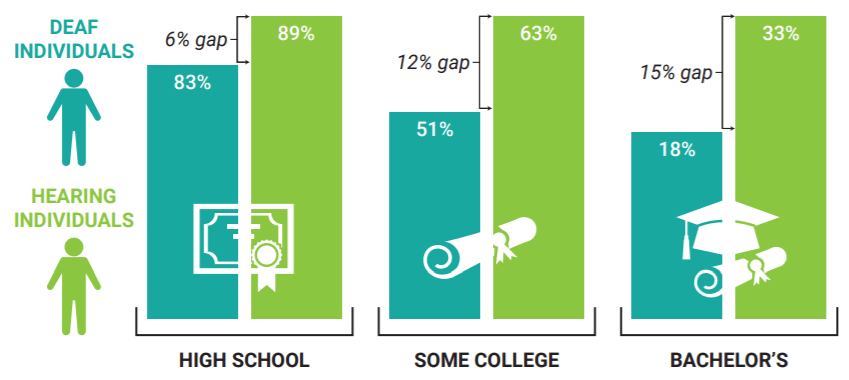
Helping teens with hearing loss succeed
Teens with hearing loss may have greater difficulty transitioning into adulthood compared to their normal hearing peers. The Phonak Teen Advisory Board explored how we can help them to succeed.
The statistics can be alarming. Only 18% of DHH students earn their undergraduate degree compared to 33% of normal hearing individuals. Looking at this graph, you can see the achievement gap doubles after high school.

Additionally, only 48% of individuals who are DHH were employed, compared to 72% of hearing people. While these statistics may not be surprising to professionals who support DHH students, they continue to be alarming and motivating.

Not only are these statistics important to educators and policy makers, but also to the teens we work with. When they turn their graduation tassel from the right to the left, that is the last time they can fully rely on supportive adults in school to advocate for them.
No longer does the hearing itinerant train the teacher, no longer can dad sit in the IEP (Individualized Education Plan) meeting with his child. Now, it’s all up to the young person. While their K-12 career was designed to help them succeed after graduation, independently advocating for their needs may still be challenging for young adults.
From theory to real life
These overwhelming statistics are what prompted the meeting between the Phonak Teen Advisory Board and Director of Programs at Hands and Voices, Lisa Kovacs last Fall. One of the keys to successful post-secondary education, Kovacs counseled the teens, is knowledge: When we know the statistics and the barriers that hearing loss can place on individuals, we can better advocate for ourselves with normal-hearing decision makers.
About a third of the Phonak Teen Advisory Board members are now in college. Their experiences remind us that there are multiple stakeholders. Even after clearly identifying their disability to their school’s Office of Accessibility/Disability, they still need to get the professor and peers to buy into using the needed accommodations. Whether its sign interpreters, CART or assistive technology, if a professor hasn’t engaged with these services before, they can be resistant to adoption.
Prove it? But how!? – Be specific
During the virtual meeting, Kovacs explained that a student’s ability to identify their disability is critical. First, one needs to describe their disability. Second, their description must include how hearing loss impacts their role as a student. Third, they have to provide a rationale for the accommodation and the tools requested.
Kovacs went on to share a powerful tactic: Before a teen tries something new, help them anticipate what will make it challenging or tricky. Role play may feel goofy – but it helps people internalize the why and the how. If a teen get to practice being in difficult situations, then when the real time comes, maybe they’ll feel less nervous and be better spoken.
How can you help? – Resources are available
- Online Module for Parents of Transition Age Students
One resource to recommend to parents is the Hands & Voices training module. This was made possible through a project of the Rehabilitation Engineering Research Center on Technology for Individuals who are Deaf or Hard of Hearing. It was funded by the National Institute on Disability, Independent Living and Rehabilitation Research.
Parents and teens can use this module to learn about the laws, tactics for advocacy, transitionary help with technology, strategies to assist in the transition process, and guidance for parents. This virtual module provides activities, readings and resources.
- Guide to Access Planning
A team of audiologists and deaf educators came together to create the Guide to Access Planning (GAP). It is a collection of assessments, checklists, facts and tools to help teens prepare for their career or college. This free tool will empower your students to be able to
- describe their disability
- improve their understanding of how their hearing loss impacts their role as a student
- provide more rational for the accommodations and tools needed
You can begin using these tools with your senior high student early in their high school education to prepare them for their future. While the statistics from the National Deaf Center may scare some, it motivates others. As the Phonak Teens learned with Kovacs, advocating for oneself with knowledge and action-oriented solutions helps DHH individuals close the educational and employment gaps.
The Guide to Access Planning tool can be found on www.phonak.com.
References
Brinkman, M. (2019) Back to School Hearing Loss Checklist. HearingLikeMe. August 21, 2019 https://www.hearinglikeme.com/back-to-school-hearing-loss-checklist/
Gaberoglio, C. L., Cawthon, S., & Bond, M. (2016) Deaf People and Employment in the United States: 2016. Washington, DC: U.S. Department of Education, Office of Special Education Programs, National Deaf Center on Postsecondary Outcomes
Gaberoglio, C. L., Cawthon, S., & Sales, A. (2017). Deaf People and Educational Attainment in the United States: 2017. Washington, DC: U.S. Department of Education, Office of Special Education Programs, National Deaf Center on Postsecondary Outcomes.
Phonak Teen Advisory Board (2019) Phonak Teen Advisory Board Virtual Meeting: Keys to successful post-secondary education. October 5, 2019. Phonak. Webex
Whicker, J. J., Thomas, F., Kipping, K. R. C, et al (2019) Vocational Rehabilitation: Educational Audiologists’ Knowledge, Attitudes, and Referral Practice Patterns. Journal of Educational, Pediatric & (Re)Habilitative Audiology Vol. 24, 2019
More about the Phonak Teen Advisory Board:
The Phonak Teen Advisory Board is made up of teenagers with hearing loss. One of their goals is to simply use the brand power of Phonak to get real stories out there. When this advisory board was started, they all looked around the room to each other and agreed to help other teens with hearing loss better advocate for themselves.
